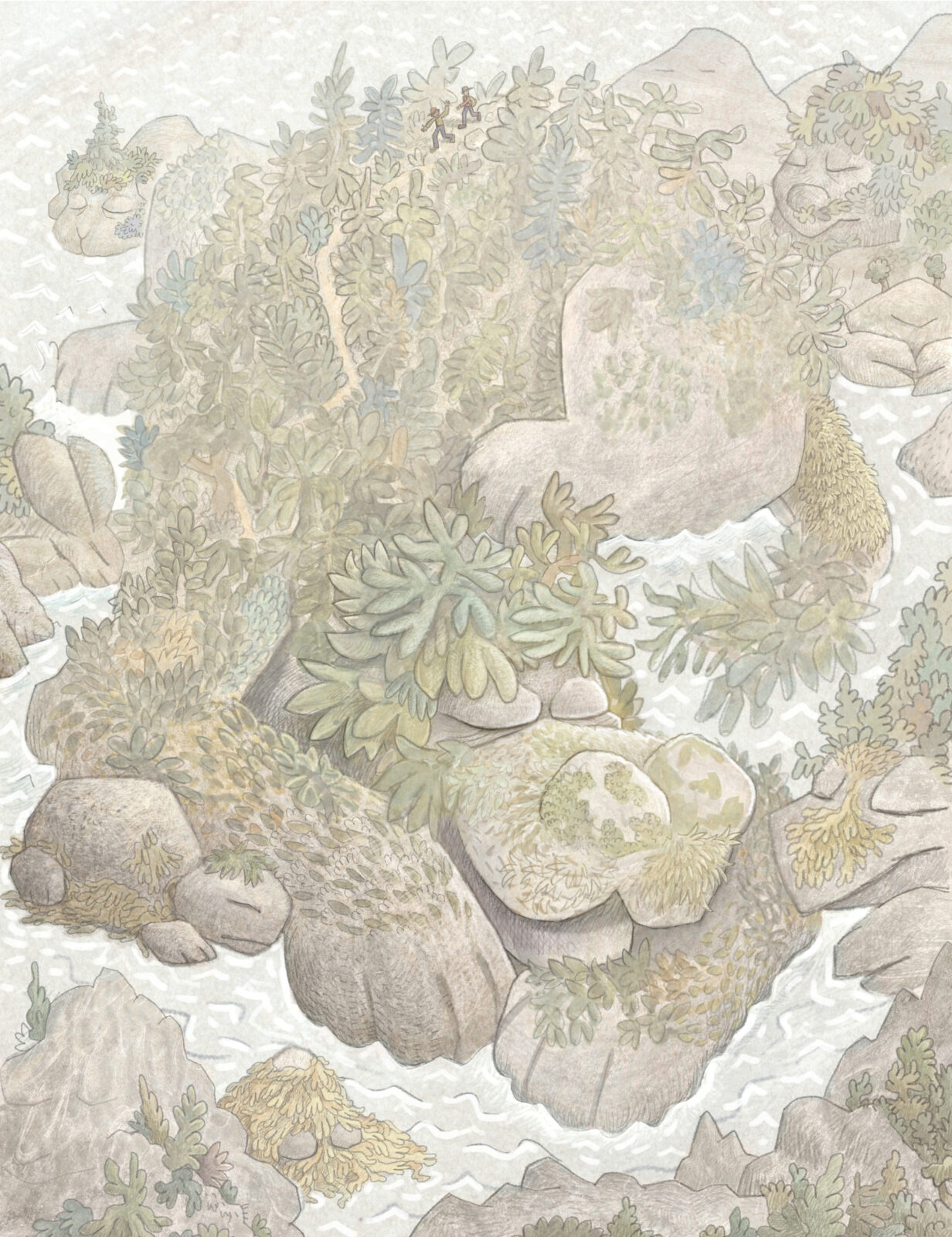
Illustration by Brendan Wenzel

Illustration by Brendan Wenzel
As we walk, the Maine forest begins to transform. Gnarled spruces emerge from the background with newfound presence. The chatter of a red squirrel vibrates through the air with surprising resonance, and even the sparkling stones we dodge along the path seem to pulse with a bit of life. This enchantment isn’t the result of magic potions or psychedelic substances but the words of the man five steps ahead.
Nick is a storyteller. He removes his orange baseball cap, as if letting a bit more of the world in, and continues his tale—an exploration of this place and our connection to it. As he speaks, his hands trace the air, sculpting invisible clay, shaping the dangling limbs, the billowy mounds of moss, and the spiky fallen cedars into one living entity. Nick knows much about this forest, but his story is more than just a description of the vast organism—it’s an invitation to become part of it. With twists, and turns, he conjures an invisible web connecting us to the forest: its chipmunks, its histories, and even the particles of pine-scented air drifting around us.
As I listen, space seems to expand. Everything shimmers. Boundaries soften, and it feels as though we are strolling across the back of some magnificent, verdant creature. I can’t help but wonder what my sneakers feel like pressing against its living skin. A faint tickle? An itch? What do we mean to each other? The experience is a gift, this sense of connection a kind of magic—all thanks to Nick’s words and the power of a well-told story. How desperately I would like to walk through that interconnected reality all the time, but with a head full of spinning thoughts, it’s hard to get there on my own. Is it possible? How do stories come to inhabit some deeper part of us?
I still dream in Maurice Sendak. Not always—certainly not as often as I’d like—but occasionally the space I slip into when I sleep feels strikingly like the strange and beautiful images of Where the Wild Things Are and In the Night Kitchen—my favorite of his books since age three. It’s not that I stroll right into a Maurice Sendak painting, but rather my dreams—their forests, their crashing waves, the unusual creatures I sometimes meet—have an undeniably Sendak-like quality to them. As a kid, I spent hours staring at those books, captivated by images of palm-peppered dreamscapes and airplanes sculpted from dough. Why have Sendak’s masterpieces, and so many books from childhood, had such a profound effect?
I think about this question often because I write and illustrate picture books. One of the greatest challenges and assets for picture bookmakers is how to work with space. With usually around thirty-two pages, plus a book cover, case, and endpaper, space is a precious resource. Many mornings are spent banging one’s head against the nearest wall, trying to edit stories down to something that will not only fit in this limited real estate but hopefully make the reader feel a little something as well.
Space is also one of the most interesting tools we picture bookmakers have to bring stories to life. It waits in the hidden corners of images. It hangs in the anticipatory breaths between page turns. It expands in the triangulated frontier between words, pictures, and most importantly, the reader. It is in these spaces that children can form their own experiences with a book. It is in these spaces that a story begins to belong to a reader, and where it feels like deep connections can be cultivated. It is why I believe my childhood books came to inhabit that deeper part of me. Sitting silently with a book in hand was an opportunity to step outside myself, to open up to other beings, other perspectives, and other ways of existing in the world. It allowed those stories to become part of me, and I suspect is the reason that decades later, I still dream in Sendak.
It is a privilege and responsibility to make books for children. The little universes we invite into being may become a few bricks of the foundation on which a young mind will begin to build their reality. What do we hope their relationship with the interconnected world will be? How do we create spaces for children to form a deeper connection to the living planet on whose back our stories unfold?
As I walk with Nick, I wonder how I might experience space differently if my friend’s story of the world had reached me when I was a kid. How might my connection to not just this place, but all places and their inhabitants be different? It makes me hopeful. My shelves are overflowing with cherished picture books, yet somehow I am more excited to see what coming generations create with this remarkable form of storytelling. How will our stories and experiences grow? What hidden spaces might be waiting to be welcomed into the foreground of our lives?

Brendan Wenzel is a New York Times bestselling author and illustrator, with great affection for all things furred, feathered and scaly. When not creating books for children, he is a proud collaborator with many groups working to protect and conserve wild places and creatures. Brendan’s book They All Saw a Cat received a 2017 Caldecott honor.
Get the latest news and stories from the Rubin, plus occasional information on how to support our work.